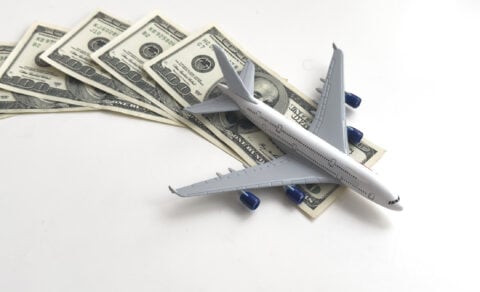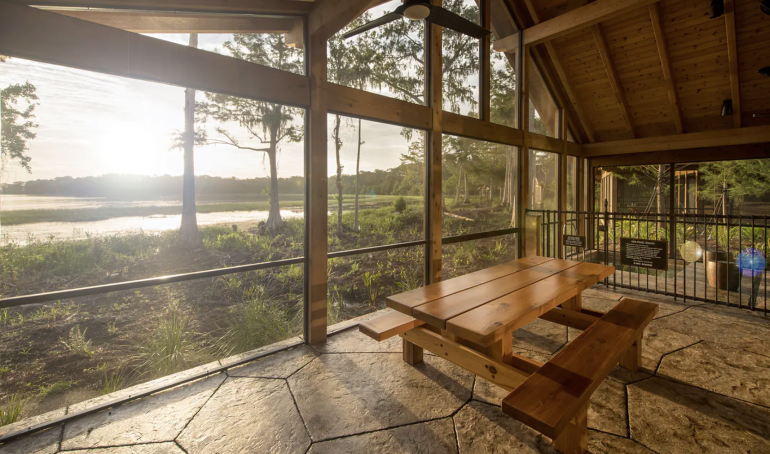The Guide to Disney Vacation Club
Travelers willing to commit to decades of Disney theme park vacations may benefit from this timeshare-like program.

Many or all of the products on this page are from partners who compensate us when you click to or take an action on their website, but this does not influence our evaluations or ratings. Our opinions are our own.
The Disney Vacation Club (DVC) is a type of timeshare program operated by The Walt Disney Co. Through it, owners buy points, called Vacation Points, which can then be redeemed on stays at Disney resorts and for other types of Disney vacations.
Some of the most ardent Disney fans sing DVC's praises because it can be a worthwhile way to save on certain types of Disney vacations — but only some. Given the limitations, high costs and serious commitment required, DVC is not for everyone.
For dedicated Mickey Mouse fans who want to bet on their long-term interest in Disney-related vacations, DVC might make some financial sense. Here’s a deep dive into what DVC offers, how much it costs and what alternative options are available for maximizing dollar spend at Disney.
What is Disney Vacation Club?
Similar to a timeshare, DVC allows you to buy Vacation Points you can redeem at eligible Disney resort properties.
Timeshares are programs that typically allow customers to purchase fractional ownership of a property, giving them a guaranteed vacation destination each year. Sometimes members are guaranteed certain times of year (e.g., the same week each year or rotating dates). Like Disney, many major hotel companies offer timeshare arms, including Marriott Vacation Club, Hilton Grand Vacation Club and Hyatt Residence Club.
But Disney’s Vacation Club works a little differently than traditional timeshares. You’re not committed to traveling at a specific property or date. Instead, participants receive points, which can be spent across all DVC resorts — and for other types of trips around the world.
🤓 Nerdy Tip
Need the DVC member login? Head here. Get the 'Cheat Codes' to Cheaper Travel
Unlocking the secret to saving a ton on travel is easier than you think. 📤 Our free newsletter shows you how in 5 min. or less.

How to become a Disney Vacation Club member
To join, you must purchase what’s referred to as “a real estate interest” in one of Disney’s participating Vacation Club resorts, which is referred to as your home resort. Resorts are primarily located in Walt Disney World in Florida (though others are sprinkled throughout the U.S.).
🤓 Nerdy Tip
Home resorts are established on your contract when you join DVC. Your home resort comes with a few perks, but you’re not locked into staying at that property or only at that property as a member. “Real estate interest” basically means you pay money in exchange for an annual allotment of Vacation Points — which aren’t exactly cheap. Expect a one-time cost of at least $30,000 to become a DVC member. Then there are closing costs, which vary based on your transaction but start at more than $380.
The costs aren’t over even after your big upfront expense. You’ll also owe recurring dues, which cost nearly $900 annually.
You can’t get out of Disney membership's recurring dues easily. When you become a DVC member, you sign a contract that typically extends 50 years from the construction date of the building you bought into. Given the huge upfront cost and decadeslong commitment, joining DVC is not a decision to be taken lightly.
Choosing a home resort
Home resorts come with perks like the Home Resort Priority Period, which gives you early access to booking stays at the property. You can reserve lodging at your home resort 11 months in advance of your desired check-in date, a full four months before booking windows open for DVC members with other home resorts.
Be thoughtful about which home resort you select because some properties are more in demand than others. Having early access to newer or more desirable resorts could improve your odds of booking a stay there.
Though you might never actually stay at your home resort. It’s not required that members complete any stays at this property; it’s more so used as a system for determining how many Vacation Points you’ll buy annually.
🤓 Nerdy Tip
Consider the potential resale value of your home resort Vacation Points as well as the potential likelihood for dues to increase. For example, an older (cheaper) property that has fallen into disrepair might undergo a greater increase in dues costs annually to cover higher maintenance costs. Note that you cannot change your home resort.
Nerdy Perspective
What are your tips for going to Disney (either in Orlando or Anaheim)?
Deciding how many Vacation Points to buy
In some ways, DVC points resemble points earned through a hotel loyalty program or hotel credit card — save for one big difference. With miles and points accrued via airline, hotel or credit card loyalty programs, you theoretically never pay for them (sure, you can buy hotel points, but NerdWallet usually doesn’t recommend that). Those points are presumably earned through credit card spending you’re doing anyway or as a thank-you for staying in a hotel.
But DVC points aren’t earned — they’re bought. And they can be pretty expensive.
For folks joining in 2024, they must purchase a minimum of 100 points, which cost more than $22,500, given their price of $225 each. Though larger groups, folks who prefer fancier properties or those who want to take longer trips would likely want more points.
Disney estimates that a family of four traveling to Disney theme parks for seven days in the summer would need 275 points ($61,875 at current rates). While 100 points can be sufficient for infrequent or lower-frills travelers, that might not even cover one night at bigger or fancier rooms within more in-demand properties, like during high season at the Copper Creek Villas & Cabins at Disney’s Wilderness Lodge in Florida.
You receive a new allotment of points every year, and — while points do expire — you can bank and borrow points from past and future years to avoid losing them.
Using Vacation Points
As is the case with redeeming hotel points through pretty much any hotel points loyalty program, DVC’s nightly point rates vary depending on factors like resort, room type and date.
The smallest rooms on low-demand nights at the lowest-cost properties, such as at Disney’s Hilton Head Island Resort, start at six points per night. An annual allotment of 100 points could get you up to 16 nights at lower-end properties like this.
Fancier properties, such as The Villas at Disney's Grand Californian Hotel & Spa, start at 17 points per night for a deluxe studio in the offseason (though deluxe studios on peak nights cost 37 points per night). A three-bedroom grand villa (which sleeps up to 12) runs as high as 224 points per night.

Other ways to use DVC points
Beyond DVC resorts, members can book other Disney vacations including Disney Cruise Line, National Geographic Expeditions and Adventures by Disney trips. Points can also be used to book other Disney vacations beyond the DVC resorts, including hotels at international theme parks such as Tokyo Disney Resort.
But these non-DVC redemptions tend to devalue your points, so NerdWallet generally doesn’t recommend using them outside of official DVC resorts.

Disney Vacation Club resorts
U.S. Disney Vacation Club resort options
Here is the full list of U.S.-based DVC resorts.
Disney Vacation Club resorts
- Bay Lake Tower at Disney’s Contemporary Resort.
- Boulder Ridge Villas at Disney’s Wilderness Lodge.
- Copper Creek Villas & Cabins at Disney’s Wilderness Lodge.
- Disney Vacation Club Villas — Aulani, A Disney Resort & Spa.
- Disney’s Animal Kingdom Villas — Jambo House.
- Disney’s Animal Kingdom Villas — Kidani Village.
- Disney’s Beach Club Villas.
- Disney’s BoardWalk Villas.
- Disney’s Hilton Head Island Resort.
- Disney’s Old Key West Resort.
- Disney’s Polynesian Villas & Bungalows.
- Disney’s Riviera Resort.
- Disney’s Saratoga Springs Resort & Spa.
- Disney’s Vero Beach Resort.
- The Villas at Disney’s Grand Californian Hotel & Spa.
- The Villas at Disney’s Grand Floridian Resort & Spa.
- The Villas at Disneyland Hotel.
Here are the DVC resorts at Walt Disney World in Florida where you can redeem DVC points as well as how many points are needed per night to book (sorted by fewest to most minimum Vacation Points needed to book):
| Resort | Starting points per night needed to book in 2024 |
|---|---|
| Disney’s Animal Kingdom Villas — Jambo House | 7. |
| Disney’s Animal Kingdom Villas — Kidani Village | 7. |
| Disney’s Saratoga Springs Resort & Spa | 9. |
| Disney’s BoardWalk Villas | 9. |
| Disney’s Old Key West Resort | 9. |
| Disney’s Riviera Resort | 10. |
| Bay Lake Tower at Disney’s Contemporary Resort | 13. |
| Boulder Ridge Villas at Disney’s Wilderness Lodge | 13. |
| Copper Creek Villas & Cabins at Disney’s Wilderness Lodge | 13. |
| Disney’s Beach Club Villas | 14. |
| Disney’s Polynesian Villas & Bungalows | 14. |
| The Villas at Disney’s Grand Floridian Resort & Spa | 16. |
And here are the DVC resorts elsewhere in the U.S. where you can redeem points (sorted by fewest to most minimum Vacation Points needed to book):
| Resort | State | Starting points per night needed to book in 2024 |
|---|---|---|
| Disney’s Hilton Head Island Resort | South Carolina. | 6. |
| Disney’s Vero Beach Resort | Florida. | 10. |
| The Villas at Disneyland Hotel | California. | 10. |
| Aulani, Disney Vacation Club Villas, Ko Olina | Hawaii. | 16. |
| The Villas at Disney’s Grand Californian Hotel & Spa | California. | 17. |
What are DVC resorts like?
Unit types
While you can use DVC points to book a classic hotel room at Disney-owned hotels, most members use them to book DVC studios or villas at designated DVC resorts.
Disney Vacation Club villas: DVC villas are more akin to vacation homes. They offer full kitchens and complimentary access to laundry facilities.
Separate bedrooms (villas have as many as three bedrooms) can accommodate larger groups and offer more privacy; the largest villas accommodate up to 12 people.
Deluxe studios: You might save points and book the (typically cheaper) deluxe studios, which still offer a kitchenette but sleep only up to five people.
And many of these studios and villas aren’t just a generic set of four walls.
DVC members at the Copper Creek Villas & Cabins at Disney’s Wilderness Lodge might stay in one of the waterfront Cascade Cabins, which feature a double-sided stone-hearth fireplace and screened-in wraparound porch with built-in hot tub.

At Disney’s Saratoga Springs Resort & Spa, you can sleep 10 feet off the ground in a Treehouse Villa.
And you don’t have to head to the other side of the globe to stay in an overwater bungalow. You can book one at Disney’s Polynesian Villas & Bungalows, where you’ll also get a private back deck and plunge pool. Plus, bungalows overlook Bay Lake, which makes for an incredible spot to watch the Magic Kingdom fireworks in the evening.
Design
Especially if you’re buying into a newer DVC resort such as Disney’s Riviera Resort and the Copper Creek Villas & Cabins at Disney’s Wilderness Lodge, rooms are spacious and thoughtfully designed to a tier higher than most other resorts. Older options with less impressive amenities include Disney's Hilton Head Island Resort, which opened in 1996.
For example, Disney’s Riviera Resort was the 2021 winner of the American Resort Development Association’s ACE Project of Excellence Award, an award within the timeshare industry. It’s hard to overlook touches throughout the grounds, like the two 20-foot-tall mosaic murals depicting scenes from “Peter Pan” and “Tangled” made from more than 1 million hand-cut tiles.

How much does the Disney Vacation Club cost?
Disney membership costs at least $33,000 to join in your first year (though financing options are available). Then there are annual dues of at least $1,000 until your contract is up, which is typically decades from now. Plus, expect annual dues to increase each year.
Costs in your first year
As of 2024, you must purchase a minimum of 100 points to start your membership. Because points cost $225 each, that’s a minimum of $22,550 for just the points
Disney's minimum buy-in cost is about average compared to the national average across all timeshares. According to the American Resort Development Association, which is a trade association representing over 350 companies within the timeshare industry the average price of a timeshare transaction is $23,940.
Then there are closing costs based on points purchased and resort type that amount to hundreds of dollars. For example, the closing costs for folks purchasing 100 Vacation Points at The Villas at Disneyland Hotel are $382.29 in 2024.
Can you finance your upfront costs?
Disney’s financing options might be worth it for some buyers, but it brings separate costs (and is available only to qualified purchasers).
Financing rates range from 10% annual percentage rate for a 10-year loan up to 18.01% APR. But financing is not a guarantee, and you may not qualify for financing depending on your credit score or financial history.
If you’re offered an interest rate on the high end, you could end up paying more in interest than the initial cost of the loan.
Costs in future years
Members also owe annual dues, which pay for operating costs, administrative expenses, refurbishment expenses and real estate taxes. Dues can be paid in one annual lump sum or monthly installments.
For example, dues for The Villas at Disneyland Hotel are $79.50 per month in 2024 for 100 points (that’s $954 for the year).
Note that dues generally increase every year. In 2024, the lowest dues increase was 1.64% (at Disney's Boardwalk Villas), but nearly half of resorts saw increases of more than 5%. A couple of resorts saw dues increases in excess of 6%. In The Villas at Disney's Grand Floridian Resort & Spa example, members got hit with a 3.28% increase in 2024 dues versus 2023. Expect similar percentage increases in future years.
Disney doesn’t exactly make this fact clear in its marketing pitch, but realize that what might feel like a minor 5% increase can quickly compound year after year — so your dues will likely be far higher years (and decades) from now than what you paid upon joining.
That’s because inflation makes the same operating expenses cost more. Then there may be increased costs for repairs and upgrades, especially at older resorts or those in harsher climates.
Then there are other potential costs you may or may not face, like late fees, bank fees and transaction fees to book non-DVC properties on points.

A hypothetical breakdown of possible costs
The exact cost of a Disney timeshare varies based on the resort, but here’s a sample breakdown using Disney's Riviera Resort as your Home Resort.
Let’s assume you’re not financing and you never get hit with extra fees like late fees. We also won’t account for additional costs like tickets or food because presumably all Disney vacationers would pay for those, DVC members or not.
The budget assumes you join in 2024 and remain a member for the next 46 years until the resort’s contract expires (which is in 2070). In this example, you buy 100 points, which is the minimum:
- Initial purchase price of 100 Vacation Points ($225 each): $22,550.
- Initial closing costs: $676.93.
- Annual dues over the next 46 years (assumes 4.1% annual increase, which was the 2024 dues increase): $120,333.65.
Grand total: $143,510.58.
When all is said and done, you’ll have paid more than $143,000 total (or an average of nearly $3,120 per year), for 46 future years of 100 annual DVC points.
Of course, every resort has varied closing costs, dues and dues increases — and each person will desire a different amount of Vacation Points — so run your own calculations to estimate the true cost of joining DVC over your lifetime.
🤓 Nerdy Tip
The program's promise is that members who plan to stay at Disney resorts (or travel to other destinations associated with the program) can save money in the long term. The company estimates that in the majority of cases, it will take 6-14 years' worth of trips before savings begin. But if you remain a member throughout the entire contract, Disney claims your savings can add up to 50%. Your mileage may vary. And note that you wouldn’t actually pay that $3,120 estimate equally every year. In actuality, you’d pay the biggest amount in your first year given the down payment. The next year would cost far less because you owe only annual dues. But annual dues costs will likely increase every year.

Is Disney Vacation Club worth it?
Is DVC worth it? NerdWallet took a deep dive into the actual price of the timeshare-like program, analyzing the pros and cons of DVC and all the costs associated with it.
Some folks who travel to Disney every year and would otherwise pay cash rates for large and luxurious suites or villa-style rooms may benefit from joining. But the reality is that even Disney will tell you not to join if your goal is making a financial investment.
“Ownership interests should not be purchased for resale or rental, as an investment opportunity, or with any expectation of achieving income, capital appreciation, or any other financial return or valuable benefit, including any tax benefit,” according to the fine print at the bottom of the DVC website.
That said, there are other reasons why DVC is worth it that go beyond the bank account. As Disney states in that same fine print, “an ownership interest should only be purchased for personal use and enjoyment.”
And there truly are oodles of other benefits for DVC members, ranging from discounts on food, merchandise and theme park tickets to money-can’t-buy experiences like members-only theme park parties and exclusive swag.
Alternatives to joining Disney Vacation Club
Some people love timeshares because they guarantee time at a resort without the inconvenience of buying a vacation home. Depending on your travel style (and especially if you travel often at that same location), timeshares can save some travelers money. But timeshares come with no shortage of pitfalls — and DVC is not immune to them.
If you want to save money on a Disney vacation without becoming a DVC member, here are some alternatives:
Rent Disney Vacation Club points
DVC members might choose to rent their points out — in turn creating a market for non-DVC renters to stay at DVC properties.
You can often book a DVC rental at a steep discount, particularly if owners are desperate to offload points. Dedicated websites broker such exchanges. While the sites take a cut of the transaction, renters should consider using them because they typically provide protections and guarantees that you wouldn’t necessarily get dealing with someone whom you found on your own, such as through a forum or Craigslist.
Buy in from the DVC resale market
You can often get great deals when you buy into DVC via a third-party reseller, who helps mediate sales from folks trying to ditch their contracts. Many of the same sites that handle DVC rentals also handle resales.
Many DVC memberships can be purchased for discounts higher than 50% when acquired through the DVC resale market.
But there are many limitations with resale, and many of DVC’s best membership benefits don’t apply when you purchase from any place other than directly with Disney. Among the most painful limitations is that DVC’s “Membership Extras” — which are some of the program’s best benefits like lounge access and restaurant discounts — are limited to folks who bought from Disney.
Use credit card rewards and travel loyalty points to book cheap Disney vacations
DVC points aren’t the only types of points that can help you fund a Disney vacation. If you have hotel points and don’t mind staying at a hotel not owned by Disney, plenty of properties affiliated with major hotel loyalty programs allow you to book stays on hotel points.
In Florida, there are more than a dozen hotels you can book on points within walking distance of Disney Springs, the resort’s shopping and dining district (which also has an abundance of Disney-run bus lines that can zip you around property at no cost). There’s also no shortage of points hotels within walking distance of Disneyland.
You can earn points by holding certain hotel–branded credit cards or other general travel rewards credit cards. And the best credit cards for Disney vacations generally aren’t the Disney-branded ones.
» Learn more: The best travel credit cards right now
Pay cash for your Disney vacations
Sometimes the simplest solution is also the smartest: skip the decades-long contracts, skip the annual dues, and just pay cash for your Disney trips as you go.
Yes, many of the same rooms you can book through DVC are also available in exchange for cash on Disney's website. And you might find those rooms even cheaper.
Third-party authorized resellers like Undercover Tourist often sell the exact same Disney hotel rooms at a discount, shaving real dollars off your total. These sites also tend to bundle in perks like tax-inclusive pricing and fee transparency, which can save you from “surprise” charges.
Cash booking also gives you the flexibility DVC can’t:
- No long-term commitment: If your vacation style changes, you’re not locked into decades of dues.
- Shop around: Compare prices across Disney’s site, third-party resellers and even credit card travel portals before booking.
- Special deals: Look out for Florida resident tickets, military discounts or limited-time offers, which DVC members don’t automatically get.
- Flexibility in lodging: Paying cash means you can switch between Disney’s budget-friendly All-Star Resorts, deluxe properties or even off-site hotels — whatever suits your budget that year.
(Top photo courtesy of Disney)
How to maximize your rewards
You want a travel credit card that prioritizes what’s important to you. Here are some of the best travel credit cards of 2025:
- Flexibility, point transfers and a large bonus: Chase Sapphire Preferred® Card
- No annual fee: Wells Fargo Autograph® Card
- Flat-rate travel rewards: Capital One Venture Rewards Credit Card
- Bonus travel rewards and high-end perks: Chase Sapphire Reserve®
- Luxury perks: American Express Platinum Card®
- Business travelers: Ink Business Preferred® Credit Card
Article sources
NerdWallet writers are subject matter authorities who use primary,
trustworthy sources to inform their work, including peer-reviewed
studies, government websites, academic research and interviews with
industry experts. All content is fact-checked for accuracy, timeliness
and relevance. You can learn more about NerdWallet's high
standards for journalism by reading our
editorial guidelines.
On this page
More like this
Related articles








